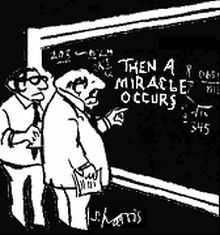An Old Lesson
I made this point back before the internet, when I first started writing. I don’t think I’ve run into this point since! Be careful with pointless metaphors:

…except I said not to do this. Say the note (or email now, I guess) is from you, not your desk!
Subscribe to this blog's RSS feed
Figures of Speech in Expository Writing
When you write to explain something, your goal is to be clear, not necessarily beautiful or picturesque. Some figures of speech are so common we don’t think of them as such; see the use of “window” in the sentence below. But how about the word “born”?
Because the cesium-rich particles were born early in the meltdown, they offer scientists an important window into the exact sequence of events in the disaster.
https://www.scientificamerican.com/article/radioactive-glass-beads-may-tell-the-terrible-tale-of-how-the-fukushima-meltdown-unfolded
Being born is normally a biological term. Might be a little better to have said “…particles were created,” eh? Or how about getting rid of the passive while we’re at it, and say that the particles formed early in the meltdown?
Not as distracting now, is it?
Rule of thumb: The more technical you are, the less poetic you should be.
Here’s a photo of the event:

The Fukushima Dai-ichi Nuclear Power plant after a massive earthquake and subsequent tsunami on March 14, 2011 in Futaba, Japan. Credit: Getty Images
Solution to the “Like or As” Problem
I never thought about considering the simile as a solution to deciding whether to use “like” or “as” in a sentence until I saw this remarkably content-free comic:

A simile is a figure of speech that compares two things (think noun) by saying one is like the other. Its companion figure of speech is metaphor, which compares two things by saying one is the other.
Simile: A donkey is like a horse
Metaphor: You, sir, are a donkey
I never heard of anyone in English class having a problem getting these right.
Deciding whether to use “like” or “as” is a different matter. And here’s the solution:
Are you comparing two things? It’s a simile—use “like.” The donkey is like a clown.
Is it about verbs or adjectives? Use “as.” The donkey is as funny as a clown (is.) He hit his head as he bent over. He’s sick as a dog (is).
(The “is” is implied; I put it in so you could see it.)
Backwards Metaphor
We had a riddle in sixth grade: How much dirt is in a hole two feet by three feet by four feet. (Well, none. A hole is empty.) I ran into someone using “massive” to refer to a hole. I’d say they have it backwards.
As you’ll see in this photo, there is a positively massive crater in the middle of the woods, and officials are operating on the principle that it was “dug by hand.”
Normally articles at Motherboard are pretty well written, but his guy was a little too informal for my taste. What’s wrong with “huge”? or “big enough to hide in”? even “curiously large”? Instead, the writer (and the editor allowed it) used a word that means “has lots of mass” to describe something empty. Here’s a picture of the hole:

Okay, the more actually massive something is, the larger it is likely to be, but this guy must not see holes very often.
Since I’m in a curmudgeonly mood, I’ll point out two more things he could improve:
- “as you’ll see…” Avoid the future tense unless you have to use it. Should have written “as you can see…”
- “there is…” Avoid using the false subject. You miss a chance to have some meaningful content when you use “there is.” How about something like “The woods near our house recently acquired a large hole…” or maybe, “An unexplained hole just appeared in our woods…”
Harrumpf.
Figures of speech part 4
Here’s a nice passage from the preface to The Journey of Man by Spencer Wells.
Our DNA carries, hidden in its string of four simple letters, a historical document stretching back to the origin of life and the first self-replicating molecules, through our amoebic ancestors, and down to the present day.
Here we have some nice examples of figurative language in what amounts to a scientific document. It’s in the preface, so the figures are appropriate, I think. Let’s take them out, and you’ll see what I mean.
Human DNA contains, in its string of billions of copies of four nucleotides, information that describes life from the time of its origin until now.
Not nearly as interesting, is it?
The original sentence contains examples of personification (ancestors), pleonasm (“present day” instead of “now”), metonymy (“letters” instead of “nucleotides”), synecdoche (“four” instead of “string of billions of copies of four”), hysteron-proteron (putting “self-replicating molecules” ahead of “the origin of life”), metaphor (“document” instead of “information”), and anabasis (adding “amoebic ancestors” between “molecules” and “present day.”) There; I think I got them all. You might include catachresis, or incongruity, since we generally consider the movement from self-replicating chemicals to humans as moving upward, but he describes the passage of time as downward (“down to the present…”). He also starts describing time as going back to the origin, and ends by coming down to the present. Adding physical directions to the passage of time is a figure of speech, too, but whatcha gonna do?
personification: attributing human characteristics to something
pleonasm: redundancy
metonymy: substituting one noun for another
synecdoche: saying a part of something, but meaning the whole thing
hysteron-proteron: putting the second thing first
metaphor: giving something another name
anabasis: going slowly upward
catachresis: being self-contradictory
Your reaction is probably surprise. To which I say, figures of speech are pretty common, aren’t they?
If you prefer, here’s a simpler approach:

